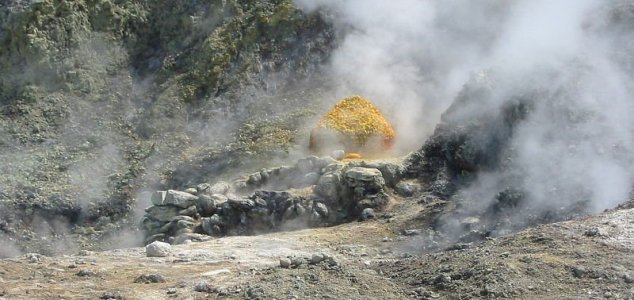Science & Technology
September 18, 2017 · 4 comments
4 comments

The status of the Campi Flegrei supervolcano remains unclear. Image Credit: CC BY-SA 3.0 Donar Reiskoffer
Using seismological techniques, scientists have now succeeded in pinpointing what they believe to be the place where hot material has been rising up from deep inside the Earth to feed the caldera.
"One question that has puzzled scientists is where magma is located beneath the caldera, and our study provides the first evidence of a hot zone under the city of Pozzuoli that extends into the sea at a depth of 4 km," said study leader Dr Luca De Siena from the University of Aberdeen.
"While this is the most probable location of a small batch of magma, it could also be the heated fluid-filled top of a wider magma chamber, located even deeper."
The last major activity in the area was back in the 1980s when the injection of magma in to the shallower part of the volcano resulted in a series of earthquakes.
"During the last 30 years the behaviour of the volcano has changed, with everything becoming hotter due to fluids permeating the entire caldera," said Dr Siena.
"Whatever produced the activity under Pozzuoli in the 1980s has migrated somewhere else, so the danger doesn't just lie in the same spot, it could now be much nearer to Naples."
"What this means in terms of the scale of any future eruption we cannot say, but there is no doubt that the volcano is becoming more dangerous."
Source: Phys.org | Comments (4)
Italian supervolcano's magma source found
By T.K. RandallSeptember 18, 2017 ·
 4 comments
4 comments
The status of the Campi Flegrei supervolcano remains unclear. Image Credit: CC BY-SA 3.0 Donar Reiskoffer
Scientists have discovered evidence of a 'hot zone' feeding a supervolcano in southern Italy.
Known as Campi Flegrei, the volcanic caldera situated to the west of Naples last erupted centuries ago, however recent findings in the area, coupled with a lack of seismic activity for several decades, have indicated that another devastating eruption may be on the cards.Using seismological techniques, scientists have now succeeded in pinpointing what they believe to be the place where hot material has been rising up from deep inside the Earth to feed the caldera.
"One question that has puzzled scientists is where magma is located beneath the caldera, and our study provides the first evidence of a hot zone under the city of Pozzuoli that extends into the sea at a depth of 4 km," said study leader Dr Luca De Siena from the University of Aberdeen.
"While this is the most probable location of a small batch of magma, it could also be the heated fluid-filled top of a wider magma chamber, located even deeper."
"During the last 30 years the behaviour of the volcano has changed, with everything becoming hotter due to fluids permeating the entire caldera," said Dr Siena.
"Whatever produced the activity under Pozzuoli in the 1980s has migrated somewhere else, so the danger doesn't just lie in the same spot, it could now be much nearer to Naples."
"What this means in terms of the scale of any future eruption we cannot say, but there is no doubt that the volcano is becoming more dangerous."
Source: Phys.org | Comments (4)

The Unexplained Mysteries
Book of Weird News
AVAILABLE NOW
Take a walk on the weird side with this compilation of some of the weirdest stories ever to grace the pages of a newspaper.
Click here to learn more

Support us on Patreon
BONUS CONTENTFor less than the cost of a cup of coffee, you can gain access to a wide range of exclusive perks including our popular 'Lost Ghost Stories' series.
Click here to learn more
United States and the Americas
Ancient Mysteries and Alternative History
Natural World
Extraterrestrial Life and The UFO Phenomenon
Total Posts: 7,609,972 Topics: 316,574 Members: 201,882
Not a member yet ? Click here to join - registration is free and only takes a moment!
Not a member yet ? Click here to join - registration is free and only takes a moment!



























Please Login or Register to post a comment.